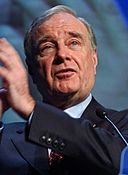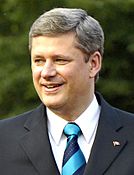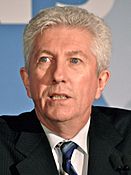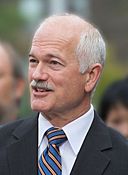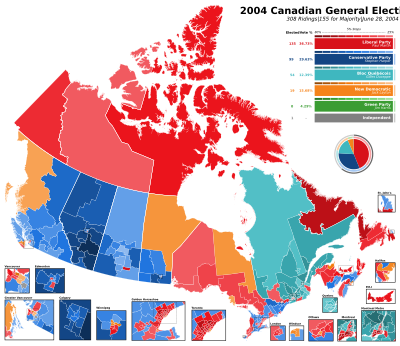2004 Canadian federal election facts for kids
The 2004 Canadian federal election happened on June 28, 2004. In this election, people voted for members to join the House of Commons of Canada, which is part of Canada's Parliament. The Liberal government, led by Prime Minister Paul Martin, lost its majority of seats. This meant they had to form a minority government, where they needed support from other parties to pass laws.
This election was also special because it was the first time the new Conservative Party of Canada ran. This party was formed by two older parties, the Progressive Conservative Party and the Canadian Alliance, joining together.
The election happened earlier than planned, even though the Liberals still had time left in their term. This was because of something called the sponsorship scandal. This scandal made many people unhappy with the Liberal government, and their popularity dropped a lot. Before this, many thought the Liberals would easily win another majority. In the end, they won a minority government, meaning they had fewer seats than before.
On election day, voting times were set so that results from most parts of Canada could be announced around the same time. However, results from Atlantic Canada were known earlier.
|
|||||||||||||||||||||||||||||||||||||||||||||||||||||||||||||||||||||||||||||
|
|
|||||||||||||||||||||||||||||||||||||||||||||||||||||||||||||||||||||||||||||
|
308 seats in the House of Commons 155 seats needed for a majority |
|||||||||||||||||||||||||||||||||||||||||||||||||||||||||||||||||||||||||||||
|---|---|---|---|---|---|---|---|---|---|---|---|---|---|---|---|---|---|---|---|---|---|---|---|---|---|---|---|---|---|---|---|---|---|---|---|---|---|---|---|---|---|---|---|---|---|---|---|---|---|---|---|---|---|---|---|---|---|---|---|---|---|---|---|---|---|---|---|---|---|---|---|---|---|---|---|---|---|
| Opinion polls | |||||||||||||||||||||||||||||||||||||||||||||||||||||||||||||||||||||||||||||
| Turnout | 60.9% ( |
||||||||||||||||||||||||||||||||||||||||||||||||||||||||||||||||||||||||||||
|
|||||||||||||||||||||||||||||||||||||||||||||||||||||||||||||||||||||||||||||
|
|
|||||||||||||||||||||||||||||||||||||||||||||||||||||||||||||||||||||||||||||

The Canadian parliament after the 2004 election
|
|||||||||||||||||||||||||||||||||||||||||||||||||||||||||||||||||||||||||||||
|
|||||||||||||||||||||||||||||||||||||||||||||||||||||||||||||||||||||||||||||
Key Issues in the Election
Several important topics were discussed during the 2004 election campaign:
Government Spending Scandal
The sponsorship scandal really hurt the Liberal Party. Other parties, especially the Bloc Québécois, used this to say that the Liberals were involved in widespread problems.
Healthcare in Canada
All parties agreed that Canada's healthcare system, called Medicare, needed improvements. They wanted to make sure people didn't have to wait too long for medical care. The Liberal government had cut some money given to provinces for healthcare, which made it harder for Paul Martin to promise improvements.
Money for Provinces
Most major parties, except the Liberals, said there was a "fiscal imbalance." This meant they believed the federal government in Ottawa had too much money compared to the provinces. They wanted to change how money was shared.
Taxes and the Economy
The Conservatives wanted to lower taxes a lot to help the economy grow. They also promised to stop giving special money to some businesses and instead give tax cuts to all businesses. The Liberals and the NDP disagreed with big tax cuts. They thought the money should be used to improve social programs for people.
Child Care Programs
Both the Liberals and the NDP promised to create national programs to help families with child care.
How Parliament Works
The Conservatives said the Liberals were making Parliament less democratic by limiting what regular Members of Parliament (MPs) could do. The Conservatives wanted changes like having an elected Senate and letting provinces review who becomes a judge. The NDP even suggested getting rid of the Senate entirely.
Election Rules
The Conservatives wanted to have fixed election dates, meaning elections would always happen on a certain day. The NDP wanted to change the voting system to proportional representation, which would give smaller parties more seats based on their vote share.
Same-Sex Marriage
The Bloc Québécois and the NDP strongly supported same-sex marriage. The NDP saw it as a human rights issue. The Liberals sent the issue to the Supreme Court to decide, and their own party members had different opinions. The Conservatives generally opposed it but said their members could vote freely on the issue.
Missile Defence
The United States government wanted Canada to join a missile defence system. The Conservatives strongly supported this idea. The Bloc Québécois and the NDP were against it. The Liberals didn't have a clear opinion on the missile shield itself.
Iraq War
The Conservatives supported the United States' actions in Iraq. Other parties generally did not support the war.
Gun Registry
The Conservatives were strongly against the national gun registry. The other main parties supported it.
Ontario Budget Issues
In Ontario, the Liberal government there introduced a new "Health Premium" tax, which was not popular. The Conservatives and NDP used this to criticize the federal Liberals, saying they were similar.
Election Results
To form a majority government in 2004, a party needed to win 155 out of 308 seats. The Liberal Party won 135 seats, which was not enough for a majority.
At first, it looked like the Liberals and the New Democratic Party (NDP) together might have enough seats for a majority. However, as the final results came in from the west coast, the Conservatives won a few very close races.
In the end, the Liberals and NDP together had 154 seats. The other 154 seats were held by the Conservatives, the Bloc Québécois, and one independent member named Chuck Cadman. Instead of forming a team with the NDP, the Liberal party decided to lead a minority government on their own. This meant they had to get support from other parties for each new law they wanted to pass.
For example, in the spring of 2005, there was a very important vote on the federal budget. The Liberals and NDP wanted the budget to pass, while the Conservatives and Bloc Québécois did not. The vote was tied, and the Speaker of the House had to cast the deciding vote, allowing the budget to pass.
The number of people who voted in this election was 60.9% of registered voters. This was the lowest voter turnout in Canadian history at that time. It was a drop of more than 3 percentage points from the 2000 federal election.
Vote and Seat Summaries
| Popular vote | ||||
|---|---|---|---|---|
| Liberal | 36.73% | |||
| Conservative | 29.63% | |||
| NDP | 15.68% | |||
| Bloc Québécois | 12.39% | |||
| Green | 4.29% | |||
| Others | 1.28% | |||
| Seat totals | ||||
|---|---|---|---|---|
| Liberal | 43.83% | |||
| Conservative | 32.14% | |||
| Bloc Québécois | 17.53% | |||
| NDP | 6.17% | |||
| Independents | 0.32% | |||
See also
 In Spanish: Elecciones federales de Canadá de 2004 para niños
In Spanish: Elecciones federales de Canadá de 2004 para niños
- List of Canadian federal general elections
- Politics of Canada
- List of political parties in Canada
- Minority governments in Canada


